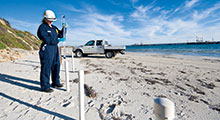


© Copyright 2017 Synergy Oil and Gas Organisation. All rights Reserved





Our goals
We identify environmental impacts and seek to avoid or minimize them.
Our sites establish annual objectives to improve environmental performance.
We put plans in place to reduce environmental risks associated with our projects and operations.
We strive to be a safety leader in our industry, a world-
We expect all our contractors and their employees to act in a way that is consistent with our code of conduct.
We are committed to meeting our obligations to the countries and communities in which we do business.


Managing our impact on the environment
Throughout the lifecycle of our projects and operations, we aim to manage environmental impacts and address any related impacts on local communities
At a group level, we annually review our management of material issues such as greenhouse gas emissions, water, and sensitive and protected areas. We seek to identify emerging risks and assess methods to reduce them across the company. For example, water scarcity is a potential risk for many of our operations, and we are working to develop tools and processes for our local businesses to use to address this issue.
Our operating management system (OMS) is designed to drive continuous improvement in environmental and social performance as part of its role as our group-
Our OMS helps our operations around the world to assess and manage their environmental and social impacts. This includes conducting an annual OMS assessment to identify risks and impacts, and then putting in place action plans to manage them.
The principles and standards of OMS are supported by our environmental and social practices. These set out how our major projects identify and manage environmental and social impacts. They also apply to projects that involve new access, projects that could affect an international protected area and some BP acquisition negotiations.
In the early planning stages, these projects complete a screening process. Results are used to identify the most significant environmental and social impacts associated with the project, with a requirement to identify mitigation measures and implement these in project design, construction and operations. From April 2010 to the end of 2012, 88 projects had completed the screening process, and used outputs of the process to implement measures to reduce impact.
Our projects can have a lifespan of several decades. Each year businesses conduct an OMS review of their environmental performance and set local improvement targets. These targets can include measures such as flaring reduction, pollution prevention, or reducing impact on bio-
Our operations are expected to work to continually reduce their impacts and risks. All our major operating sites, are required to be certified to the environmental management system standard ISO 14001, and publish an externally verified environmental statement.
Q: How does SYNERGY set targets for environmental performance?
A: Operations set environmental targets at a local level, based on an assessment of their most significant environmental aspects. Annual plans are developed to meet these targets, and the environment teams review progress annually with local management. For example, in my prior role as the environment director for Alaska, we set out to improve our solid waste handling, with the aim of reducing the amount of waste sent to landfill. In 2011 we set up an additional solid waste collection site which means that we are now consolidating waste from across the field, allowing for better handling of recyclables.
Complying with regulations
With our operations, SYNERGY faces diverse and complex environmental laws and regulations within international, national, regional and local jurisdictions
We manage applicable legal and regulatory health, safety, security and environmental (HSSE) requirements through our operating management system (OMS), which includes requirements on HSSE compliance management systems. We strive to continuously improve performance by enhancing OMS and by sharing good practices.
Across the company, we have deployed and continue to strengthen tools, systems and capabilities for managing HSSE compliance with applicable regulations.
Where regulations are already in place our businesses strive to comply fully with them at all times. Where regulations are under development, BP may seek to participate in the regulatory process while preparing for compliance with the likely regulations.
Regulations on environmental remediation
Some environmental laws also require us to re mediate and restore areas affected by accidental or non-
Our remediation specialists work to identify, manage and reduce our soil and groundwater impacts –returning sites to a suitable condition and reducing the group’s financial environmental burden. These specialists also work proactively with the regulating agencies in many countries to find suitable solutions for the clean-
Our people and values
We value diversity of people and thought, and we aim to make sure that everyone at SYNERGY is treated with respect and dignity
Our commitment to high ethical standards and compliance with applicable laws wherever we operate


Each year, we engage our employees in code of conduct certification. Participation in code of conduct certification is mandatory for senior leaders up to the group chief executive and is also open to all other employees. When participants complete their certification, a record is kept that they understand the code and have been in compliance with its requirements. Code certification reminds individuals of their accountability to uphold BP’s values, to do the right thing and to create an environment where people can confidently raise concerns.







